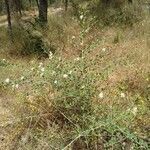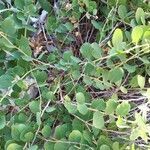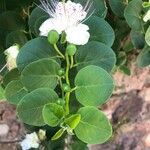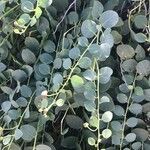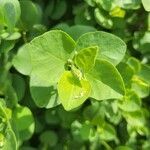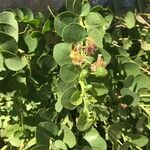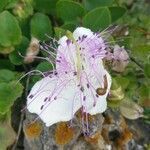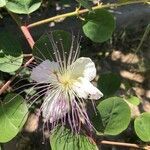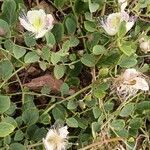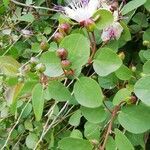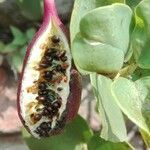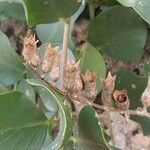Shrubs, prostrate or hanging, 50-80(-100) cm tall. Twigs glabrous to densely long or shortly white pubescent with simple trichomes, soon glabrescent. Stipular spines 4-5 mm, ± flat, apex recurved. Petiole 1-4 mm; leaf blade ovate, obovate, broadly elliptic, or suborbicular, 1.3-3 × 1.2-2 cm, 1-1.7 × as long as wide, fleshy when fresh but later leathery, midvein abaxially raised but gradually becoming obscure from base to apex, secondary veins 4(or 5) on each side of midvein, base rounded, apex acute, obtuse, or retuse but spine-tipped. Flowers solitary in upper axils; buds ± symmetrical. Pedicel 2-6(-9) cm. Calyx zygomorphic; sepals 1.5-2 × 0.6-1.1 cm, outside ± with trichomes, inside glabrous; sepals of outer whorl navicular-lanceolate, outside with several glands, basally shallowly saccate; sepals of inner whorl 1-2 cm, not saccate or galeate, not broadest near base, 3-4.5 mm deep in distal half. Petals dimorphic, ± as long as or slightly longer than anterior sepals; anterior 2 petals white, distinct, claw 4-7 mm, blade oblong-obovate, 1-2 cm, outside with trichomes, apex subemarginate; posterior 2 petals yellowish green to green, enclosed by sepals, thickened, margin connate from base almost to middle. Stamens ca. 80; filaments 2-4 cm, unequal; anthers 2-3 mm. Gynophore ca. 1 cm, sometimes basally sparsely villous; ovary ellipsoid, 3-4 mm, glabrous, apically with vertical thin furrow and ridge; placentae 6-8; ovules numerous; style and stigma obscure, moundlike. Fruit dark green when dry, ellipsoid to oblong-obovoid, 1.5-4 × 0.8-1.8 cm, with 6-8 lengthwise thin ridges, dehiscent; fruiting pedicel and gynophore 3-7 cm, 1.5-2 mm in diam., forming a right angle with each other. Seeds 40-60 per fruit, reddish brown, reniform to globose, 3-4 mm, smooth. Fl. Jun-Jul, fr. Aug-Sep. 2n = 24.
More
A small dense shrub. It grows 1-2 m high. The branches are zigzag and spiny. The thorns are straight. The leaves are rounded and thick. They are dull green and 2-4 cm across. They are covered with a white covering. The flowers are in the axils of leaves. The flowers are white. They have 3 petals. They are about 6 cm across. The fruit is a round berry. It is about 3 cm long. It bursts open when ripe.
